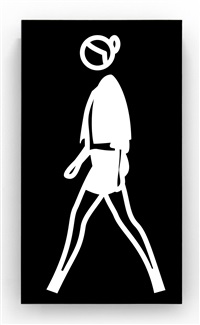Julian Opie is a representational artist. His portraits are seem to be understood more by symbol than by actual mimetic desire to get to the essence of the thing. Or maybe I'm wrong, by stripping down his drawings to the bare minimum he is getting to the very core of the essence of the thing. he is very famous and is known throughout the world. I find his work simplistic but intriguing. He reduces things down to their most basic form that is still recognizable without having to think about what it is that is being represented. Julian was born in London and continues to work there. His work reminds me of Andy Warhol in the way that he takes the form and makes it highly stylized in a way that is easily recognizable as his work. His work makes me think of avatars, traffic signs, and symbols. he uses shapes and symbols that are so prevalent in our daily lives that even though they are far from the actual image, they are easily recognized as the form or figure that the artist wants us to see. I think that this could be a fun idea to explore - how far away from the actual visual truth of an image can we go and still have the image be instantly recognizable?
Julian Opie is a representational artist. His portraits are seem to be understood more by symbol than by actual mimetic desire to get to the essence of the thing. Or maybe I'm wrong, by stripping down his drawings to the bare minimum he is getting to the very core of the essence of the thing. he is very famous and is known throughout the world. I find his work simplistic but intriguing. He reduces things down to their most basic form that is still recognizable without having to think about what it is that is being represented. Julian was born in London and continues to work there. His work reminds me of Andy Warhol in the way that he takes the form and makes it highly stylized in a way that is easily recognizable as his work. His work makes me think of avatars, traffic signs, and symbols. he uses shapes and symbols that are so prevalent in our daily lives that even though they are far from the actual image, they are easily recognized as the form or figure that the artist wants us to see. I think that this could be a fun idea to explore - how far away from the actual visual truth of an image can we go and still have the image be instantly recognizable?


Comments
Post a Comment